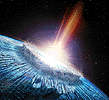
Directed by Mimi Leder
Visual Effects Supervisor: Scott Farrar

Directed by Mimi Leder
Visual Effects Supervisor: Scott Farrar
PACIFIC TITLE/MIRAGE
CIS HOLLYWOOD
Review by Todd Vaziri
One of Industrial Light & Magic's big feature films of the year, DEEP IMPACT--the story of a giant comet headed toward Earth. The film contains a great deal of innovative, visually interesting effects work. The choreography and composition of the disaster-related effects are reminiscent of great disaster effects films of the past, especially 1996's INDEPENDENCE DAY. And while the spacebound effects shots are stunning, they were suprisingly scant. ILM handled the hero disaster and space visual effects, while CIS and Pacific Title/Mirage turned in plenty of composites, as well.
One of ILM's greatest strengths is its model shop, which turned in another group of fantastic miniature models. The models of the Messiah, the specially fitted space shuttle that zips our heroes to the comet en route, hold up especially well. The scale of the shuttle looks dead on, even as the craft swings close to the camera, as lighting and composites remained consistent and quite believable.
 Visual Effects Produced by:
Visual Effects Produced by:
INDUSTRIAL LIGHT & MAGIC
Co-VFX Supervisor: Bill George
VFX Producer: Denise Ream
Executive Producer: Joe Gareri
VFX Supervisor: Dr. Ken Jones
tvaziri@gmail.com
 The comet flies parallel to the surface just before it hits. The deep, dark smoke trail that it leaves is intensely realistic, as is the ripple effect of the comet's shockwave on the water. Below, the Messiah spacecraft leaves its orbital space station, and the Messiah, flying in the tail of the comet, gets nailed by a huge chunk of rock. 
 |
A single shot of the Earth later in the film, with its atmosphere gleaming across the globe and the sun behind it, featured some nasty banding, much like a similar shot from ALIEN RESURRECTION, where gradients of light areas to dark areas appear banded.
The comet itself is quite interesting, with the massive rock emitting streams of gases and particles. The Messiah's trip into the comet's tail is exciting, with huge rocks smashing into the craft before it descends on the comet's surface. Camera shake was motivated and worked extremely well throughout these shots. Surface shots were accomplished with huge real-life set pieces and virtual sets, created with CG and miniatures. Always present were gaseous emissions emanating from the surface--even in hand-held camera moves, the CG gases seemed to be part of the scene, a complement to the 3D matchmoving and compositing teams. Among the fine surface shots an over the shoulder rack focus of an astronaut turning around to see the lander vehicle approaching, and another tilt-up shot of an astronaut getting blasted into space by one of the comet's geysers. The tilt up is especially sucessful because of the lateness of the tilt--the camera lifts a few moments after the geyser blows, as if an actual cameraman were photographing the event, live. Throughout the movie, there are countless wire-removals and windshield bluescreen composites that are completely invisible, even during dolly and handheld camera moves. Zero gravity in the Messiah was accomplished by hanging the actors and props on wires, wires which then need to be painstakingly

Download a montage of ILM's effects from DEEP IMPACT, edited by VFX HQ. ~2.8MB |
Then, the comet hits. Probably the most incredible shots of the film take place as the comet zooms parallel to the surface of the Earth. The shimmering fireball leaves a dark, puffy smoke trail that looks incredibly realistic. Upon impact, it creates the 3000 foot tall tidal wave that eventually destroys the eastern seaboard of the United States.
Many of the disaster shots that follow are eerily reminiscent of similar shots from INDEPENDENCE DAY. Instead of a wall of fire enveloping and destroying New York skyscrapers, it's water. And what's most incredible is the dazzlingly realistic CG water used throughout the film. In fact, not a drop of real water was photographed for the film's effects. (A previous version of this review incorrectly stated the use of both CG and real water.) The single best shot of the destruction of New York is an overhead view of the city streets overcome with water. Visible on buildings' roofs are panicking New Yorkers, who desperately try to run away from their impending doom.
Along a Virginia highway, the tidal wave approaches. Careful matchmoving allowed the camera to crane up and over as the wave destroys the landscape and flips over cars. The camera was rarely motionless, which lends a lot of energy to the sequence. As our heroes narrowly escape the water's path, a helicopter shot reveals the damage caused by the wave, in one of the least successful effects shots of the film. The matte painting and 3D elements that make up the destroyed landscape are blurry and obviously synthetic, while the match moving left a lot to be desired.
INDEPENDENCE DAY's destruction montage was more satisfying than DEEP IMPACT's, because of the dozens upon dozens of shots in ID4's sequence. DEEP IMPACT's wave shots, while technically and aesthetically successful, have less of an impact on the viewer because of their infrequent appearances. But the work in DEEP IMPACT furthers the notion that CG effects cannot entirely replace physical and miniature effects--doses of both miniature photography and digitally created elements are still required to create feature film illusions.
Check out Cinefex 74.
Official Web Site: http://www.deep-impact.com
TM & Copyright 1997 Paramount Pictures and Dreamworks LLC

. . VFX HQ Produced by Todd Vaziri . . http://www.vfxhq.com . . e-mail: tvaziri@gmail.com . .
All text Copyright © 1998 Todd Vaziri, unless otherwise noted